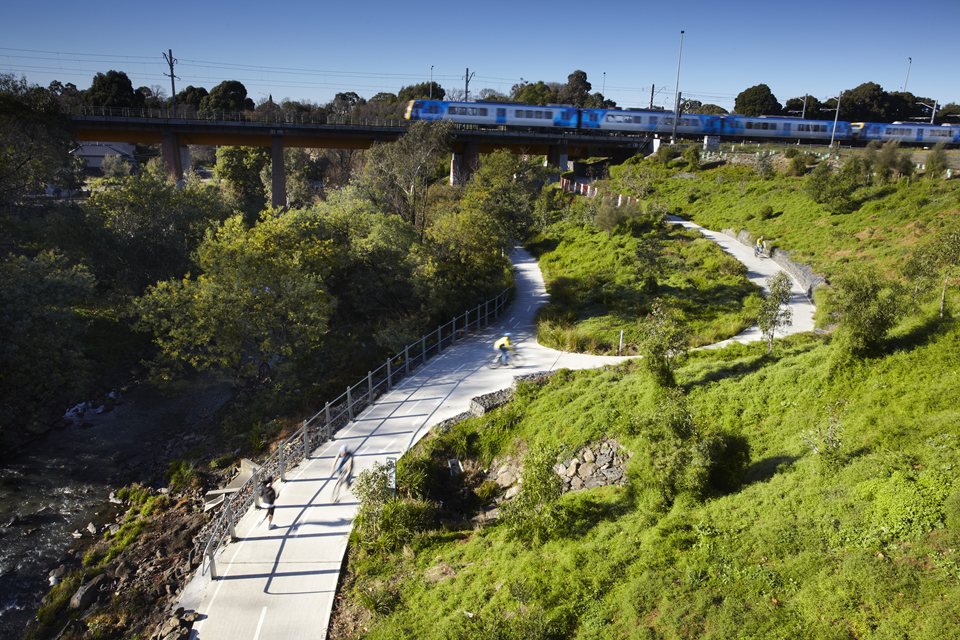Jeavons Landscape Architects are the winners of this year's Landscape award for the design of new green infrastructure along the Merri Creek corridor in Victoria.
The duplication of the railway track between Clifton Hill and Westgarth Stations was a key public transport initiative to improve Melbourne’s public transport service, requiring a second rail bridge to be constructed over the Merri Creek (bridgework completed in 2009).
The project required the blending of technically challenging design with aesthetics while balancing high community expectations, including addressing the engineering and operational requirements for the railway and co-ordination with multiple authorities two local councils, Melbourne Water, and numerous road and rail authorities.
The design was based on scientific research by the Australian Research Centre for Urban Ecology and sought to recreate locally indigenous flora communities of similar species composition and structure to the original ecology. Over 48,000 local indigenous plants were installed.

The judges said: "Beginning in what has been a highly degraded site in need of rejuvenation, the project does a lot to restore the biodiversity and repair the riparian environment.
The great effort made in community consultation and after 48,000 indigenous plantings has resulted is an attractive space in all its minutiae.
"It is an unassuming intervention which appears as though it may have been there for a long time. It is a delight to see."
INITIATIVES
-
Managing impacts on the Merri Creek corridor including visual impact, recreational trails, natural values, flood flows
-
Restoration of the indigenous creek vegetation and environment, dealing with runoff
-
protection of Aboriginal and non indigenous heritage values (original bridge is heritage listed)
-
Functional and amenity considerations such as pedestrian and cycle routes, design of the interface between the railway and local streets, fully accessible pedestrian crossings over the tracks, viewpoints, safety & sightlines; cycleway signage.
-
Design of a complex intersection on the capital city bike path up a steep slope , advocacy for open space and design of a new small park under the bridge (Bridge Park)
-
Temporary re-routing of cycle networks, and creation of works plans to ensure runoff and the impact of site works were minimised during construction.
-
Merri Creek biodiversity restored
-
The design sought to recreate locally indigenous flora communities of similar species composition and structure to the original ecology.
-
Over 48,000 local indigenous plants were installed after rigorous research.
-
The design approach incises natural vegetation layers with sinuous walls and paths that merge with the organic landforms. A major staircase structure on the south bank cascades down the slope, its basalt sides and angular corten panels evoking the blocky forms, and textures of the basalt cliffs of the valley. The design concept is expressed eloquently in the built form as follows:
-
Restoration of the natural environment with indigenous species and ecological structure based on published research guidelines for the Merri creek valley.
-
The existing heritage listed rail bridge and railway context are reflected and expressed in the landscape through raw materials– corten steel, bluestone slabs and railway ballast gabions.
-
The vegetation composition is tailored to suit each micro-climate from the water’s edge and lower slopes, through the mid-slope, top of slope, cliff-face and grassy woodlands. Our designs are based on the DSE’s ecological vegetation classes, recent research by ARCUE and recommendations of the Merri Creek Management Committee.
-
Bluestone emerged as a significant material, reflecting both natural and social history. As the natural site bedrock and the traditional streetscape material, the sawn, vertical bluestone slabs with broken ends reflect the local basalt cliff-faces provide a contemporary twist and also meet local heritage requirements.
-
Making use of ‘broken’ seconds unusable for Melbourne’s footpaths, these are an especially sustainable, durable material quarried and sawn in Victoria. Basalt also features crushed as railway ballast in the feature gabion walls, and as mulch.
Images by Andrew Lloyd: www.lloydphoto.com.au

